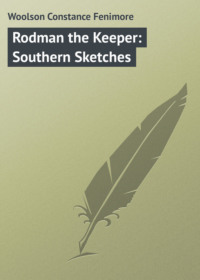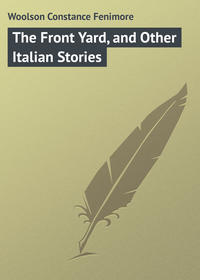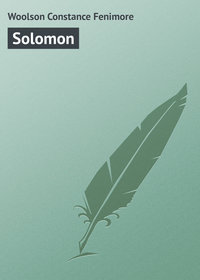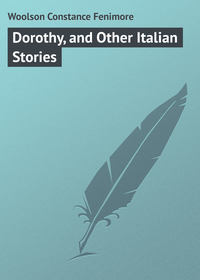 полная версия
полная версияMentone, Cairo, and Corfu
The president of El Azhar occupies, in native estimation, a position of the highest authority. Napoleon, recognizing this power, requested the aid of his influence in inducing Cairo to surrender in 1798. The sheykh complied; and a month later the wonderful Frenchman, in full Oriental costume, visited the university in state, and listened to a recitation from the Koran.
Now that modern schools have been established by the government in addition to the excellent and energetic mission seminaries maintained by the English, the Americans, the Germans, and the French, one wonders whether this venerable Arabian college will modify its tenets or shrink to a shadow and disappear. There are hopeful souls who prophesy the former; but I do not agree with them. Let us aid the American schools by all the means in our power. But as for El Azhar, may it fade (as fade it must) with its ancient legends draped untouched about it.
All who visit Cairo see the Assiout ware – pottery made of red and black earth, and turned on a wheel; it comes from Assiout, two hundred and thirty miles up the Nile, and the simple forms of the vases and jugs, the rose-water stoups and narrow-necked perfume-throwers, are often very graceful. Assiout ware is offered for sale in the streets; but the itinerant venders are sent out by a dealer in the bazaars, and the fatality which makes it happen that the vender has two black stoups and one red jug when you wish for one black stoup and two red jugs sent us to headquarters. But the crowded booth did not contain our heart's desire, and as we still lingered, making ourselves, I dare say, too pressing for the Oriental ease of the proprietor, it was at last suggested that Mustapha might perhaps go to the store-room for more – ? (the interrogation-point meaning backsheesh). Seizing the opportunity, we asked permission to accompany the messenger. No one objecting – as the natives consider all strangers more or less mad – we were soon following our guide through a dusky passageway behind the shop, the darkness lit by the gleam of his white teeth as he turned, every now and then, to give us an encouraging smile and a wink of his one eye, over his shoulder. At length – still in the dark – we arrived at a stairway, and, ascending, found ourselves in a second-story court, which was roofed over with matting. This court was surrounded by chambers fitted with rough, sliding fronts: almost all of the fronts were at the moment thrown up, as a window is thrown up and held by its pulleys. In one of these rooms we found Assiout ware in all its varieties; but we made a slow choice. We were evidently in a lodging-house of native Cairo; all the chambers save this one store-room appeared to be occupied as bachelors' apartments. The two rooms nearest us belonged to El Azhar students, so Mustapha said: he could speak no English, but he imparted the information in Arabic to our dragoman. Seeing that we were more interested in the general scene than in his red jugs, Mustapha left the Assiout ware to its fate, and, lighting a cigarette, seated himself on the railing with a disengaged air, as much as to say: "Two more mad women! But it's nothing to me." One of the students was evidently an ascetic; his room contained piles of books and pamphlets, and almost nothing else; his one rug was spread out close to the front in order to get the light, and placed upon it we saw his open inkstand, his pens, and a page of freshly copied manuscript. When we asked where he was, Mustapha replied that he had gone down to the fountain to wash himself, so that he could say his prayers. The second chamber belonged to a student of another disposition; this extravagant young man had three rugs; clothes hung from pegs upon his walls, and he possessed an extra pair of lemon-colored slippers; in addition we saw cups and saucers upon a shelf. Only two books were visible, and these were put away in a corner; instead of books he had flowers; the whole place was adorned with them; pots containing plants in full bloom were standing on the floor round the walls of his largely exposed abode, and were also drawn up in two rows in the passageway outside, where he himself, sitting on a mat, was sewing. His blossoms were so gay that involuntarily we smiled. Whereupon he smiled too, and gave us a salam. Opposite the rooms of the students there was a large chamber, almost entirely filled with white bales, like small cotton bales; in a niche between these high piles, an old man, kneeling at the threshold, was washing something in a large earthen-ware tub of a pink tint. His body was bare from the waist upward, and, as he bent over his task, his short chest, with all the ribs clearly visible, his long brown back with the vertebræ of the spine standing out, and his lean, seesawing arms, looked skeleton-like, while his head, supported on a small wizened throat, was adorned with such an enormous bobbing turban, dark green in hue, that it resembled vegetation of some sort – a colossal cabbage. Directly behind him, also on the threshold, squatted a large gray baboon, whose countenance expressed a fixed misanthropy. Every now and then this creature, who was secured by a long, loose cord, ascended slowly to the top of the bales and came down on the other side, facing his master. He then looked deeply into the tub for several minutes, touched the water carefully with his small black hand, withdrew it, and inspected the palm, and then returned gravely, and by the same roundabout way over the bales, to resume his position at the doorsill, looking as if he could not understand the folly of such unnecessary and silly toil.
In another chamber a large, very black negro, dressed in pure white, was seated upon the floor, with his feet stretched out in front of him, his hands placed stiffly on his knees, his eyes staring straight before him. He was motionless; he seemed hardly to breathe.
"What is he doing?" I said to the dragoman.
"He? Oh, he berry good man; he pray."
In a chamber next to the negro two grave old Arabs were playing chess. They were perched upon one of those Cairo settees which look like square chicken-coops. One often sees these seats in the streets, placed for messengers and porters, and for some time I took them for actual chicken-coops, and wondered why they were always empty. Chickens might well have inhabited the one used by the chess-players, for the central court upon which all these chambers opened was covered with a layer of rubbish and dirt several inches thick, which contained many of their feathers. It was upon this same day that we made our search for the Khan of Kait Bey. No dragoman knows where it is. The best way, indeed, to see the old quarters is to select from a map the name of a street as remote as possible from the usual thoroughfares beloved by these tasselled guides, and then demand to be conducted thither.
We did this in connection with the Khan of Kait Bey. But when we had achieved the distinction of finding it, we discovered that it was impossible to see it. The winding street is so narrow, and so constantly crowded with two opposed streams of traffic, that your donkey cannot pause to give you a chance to inspect the portion which is close to your eyes, and there is no spot where you can get a view in perspective of the whole. So you pass up the lane, turn, and come down again; and, if conscientious, you repeat the process, obtaining for all your pains only a confused impression of horizontal plaques and panels, with ruined walls tottering above them, and squalid shops below. There is a fine arched gateway adorned with pendentives; that, on account of its size, you can see; it leads into the khan proper, where were once the chambers for the travelling merchants and the stalls for their beasts; but all this is now a ruin. One of the best authorities on Saracenic art has announced that this khan is adorned with more varieties of exquisite arabesques than any single building in Cairo. This may be true. But to appreciate the truth of the statement one needs wings or a ladder. The word ladder opens the subject of the two ways of looking at architecture – in detail or as a whole. The natural power of the eye has more to do with this than is acknowledged. If one can distinctly see, without effort and aid, a whole façade at a glance, with the general effect of its proportions, the style of its ornament, the lights and shadows, the outline of the top against the sky, one is more interested in this than in the small traceries, for instance, over one especial window. There are those of us who remember the English cathedrals by their great towers rising in the gray air, with the birds flying about them. There are others who, never having clearly seen this vision – for no opera-glass can give the whole – recall, for their share of the pleasure, the details of the carvings over the porches, or of the old tombs within. It is simply the far-sighted and the near-sighted view. Another authority, a master who has had many disciples, has (of late years, at least) devoted himself principally to the near-sighted view. In his maroon-colored Tracts on Venice he has given us a minute account of the features of the small faces of the capitals of the columns of the Doge's palace (all these ofs express the minuteness of it); but when we stand on the pavement below the palace – and naturally we cannot stand in mid-air – we find that it is impossible to follow him: I speak of the old capitals, some of which are still untouched. The solution lies in the ladder. And Ruskin, as regards his later writings, may be called the ladder critic. The poet Longfellow, arriving in Verona during one of his Italian journeys, learned that Ruskin was also there, and not finding him at the hotel, went out in search of his friend. After a while he came upon him at the Tombs of the Scaligers. Here high in the air, at the top of a long ladder, with a servant keeping watch below, was a small figure. It was Ruskin, who, nose to nose with them, was making a careful drawing of some of the delicate terminal ornaments of those splendid Gothic structures. One does not object to the careful drawings any more than to the descriptions of the little faces at Venice. They are good in their way. But one wishes to put upon record the suggestion that architectural beauty as viewed from a ladder, inch by inch, is not the only aspect of that beauty; nor is it, for a large number of us, the most important aspect. A man who is somewhat deaf, if talking about a symphony, will naturally dwell upon the strains which he has heard – that is, the louder portions; but he ought not therefore to assume that the softer notes are insignificant.
THE DERVISHESOn the 31st of January, 1890, we took part in a horse-race. It was a long race of great violence, and the horses engaged in it were disgracefully thin and weak. "Very Mohammedan – that," some one comments. The race was Mohammedan from one point of view, for it was connected with the dervishes, Mohammedans of fanatical creed. The dervishes, however, remained in their monasteries – with their fanaticism; the race was made by Christians, who, crowded into rattling carriages, flew in a body from the square of Sultan Hassan through the long, winding lanes that lead towards Old Cairo at a speed which endangered everybody's life, with wheels grating against each other, coachmen standing up and yelling like demons, whiplashes curling round the ribs of the wretched, ill-fed, galloping horses, and natives darting into their houses on each side to save themselves from death, as the furious procession, in clouds of dust, rushed by. The cause of this sudden madness is found in the fact that the two best-known orders of these Mohammedan monks (one calls them monks for want of a better name; they have some resemblance to monks, and some to Freemasons) go through their rites once a week only, and upon the same afternoon; by making this desperate haste it is possible to see both services; and as travellers, for the most part, make but a short stay in Cairo, they find themselves taking part, nolens volens, in this frantic progress, led by their ambitious dragomans, who appear to enjoy it. The service of the Dancing Dervishes takes place in their mosque, which is near the square of Sultan Hassan. Here they have a small circular hall; round this arena, and elevated slightly above it, is an aisle where spectators are allowed to stand; over the aisle is the gallery. This January day brought a crowd of visitors who filled the aisle completely. Presently a dervish made the circuit of the empty arena, warning, by a solemn gesture, those who had seated or half-seated themselves upon the balustrade that the attitude was not allowed. As soon as he had passed, some of the warned took their places again. Naturally, these were spectators of the gentler sex. I am even afraid that they were pilgrims from the land where the gentler sex is accustomed from its earliest years to a profound deference. Two of these pretty pilgrims transgressed in this way four times, and at last the dervish came and stood before them. They remained seated, returning his gaze with amiable tranquillity. What he thought I do not know – this lean Egyptian in his old brown cloak and conical hat. I fancied, however, that it had something to do with the great advantages of the Mohammedan system regarding the seclusion of women. He did not conquer.
At length began the music. The band of the dervishes is placed in one of the galleries; we could see the performers squatting on their rugs, the instruments being flutes or long pipes, and small drums like tambourines without the rattles. Egyptian music has a marked time, but no melody; no matter how good an ear one has, it is impossible to catch and resing its notes, even though one hears them daily. Pierre Loti writes: "The strains of the little flutes of Africa charm me more than the most perfect orchestral harmonies of other lands." If by this he means that the flutes recall to his memory the magic scenes of Oriental life, that is one thing; but if he means that he really loves the sounds for themselves, I am afraid we must conclude that this prince of verbal expression has not an ear for music (which is only fair; a man cannot have everything). The band of the dervishes sends forth a high wail, accompanied by a rumble. Neither, however, is distressingly loud.
Meanwhile the dervishes have entered, and, muffled in their cloaks, are standing, a silent band, round the edge of the arena; their sheykh – a very old man, much bent, but with a noble countenance – takes his place upon the sacred rug, and receives with dignity their obeisances. All remain motionless for a while. Then the sheykh rises, heads the procession, and, with a very slow step, they all move round the arena, bowing towards the sacred carpet as they pass it. This opening ceremony concluded, the sheykh again takes his seat, and the dervishes, divesting themselves of their cloaks, step one by one into the open space, where, after a prayer, each begins whirling slowly, with closed eyes. They are all attired in long, full white skirts, whose edges have weights attached to them; as the speed of the music increases, their whirl becomes more rapid, but it remains always even; though their eyes are closed, they never touch each other. From the description alone, it is difficult to imagine that this rite (for such it is) is solemn. But looked at with the actual eyes, it seemed to me an impressive ceremony; the absorbed appearance of the participants, their unconsciousness of all outward things, the earnestness of the aspiration visible on their faces – all these were striking. The zikr, as this species of religious effort is named, is an attempt to reach a state of ecstasy (hallucination, we should call it), during which the human being, having forgotten the existence of its body, becomes for the moment spirit only, and can then mingle with the spirit world. The Dancing Dervishes endeavor to bring on this trance by the physical dizziness which is produced by whirling; the Howling Dervishes try to effect the same by swinging their heads rapidly up and down, and from side to side, with a constant shout of "Allah!" "Allah!". The latter soon reach a state of temporary frenzy. For this reason the dancers are more interesting; their ecstasy, being silent, seems more earnest. The religion of the Hindoos has a similar idea in another form – namely, that the highest happiness is a mingling with God, and an utter unconsciousness of one's humanity. Christian hermits, in retiring from the world, have sought, as far as possible, the same mental condition; but for a lifetime, not, like the dervishes, for an hour. These enthusiasts marry, if they please; many of them are artisans, tradesmen, and farm laborers, and only go at certain times to the monasteries to take part in the zikrs. There are many different orders, and several other kinds of zikr besides the two most commonly seen by travellers.
Travellers see also the Mohammedan prayers. These prayers, with alms-giving, fasting during the month Ramadan, and the pilgrimage to Mecca, are the important religious duties of all Muslims. The excellent new hotel, the Continental, where we had our quarters, a hotel whose quiet and comfort are a blessing to Cairo, overlooked a house which was undergoing alteration; every afternoon at a certain hour a plasterer came from his work within, and, standing in a corner under our windows, divested himself of his soiled outer gown; then, going to a wall-faucet, he turned on the water, and rapidly but carefully washed his face, his hands and arms, his feet, and his legs as far as his knees, according to Mohammed's rule; this done, he took down from a tree a clean board which he kept there for the purpose, and, placing it upon the ground, he kneeled down upon it, with his face towards Mecca, and went through his worship, many times touching the ground with his forehead in token of self-humiliation. His devotions occupied five or six minutes. As soon as they were over, the board was quickly replaced in the tree, the soiled gown put on again, and the man hurried back to his work with an alertness which showed that he was no idler.
On the Nile, at the appointed hour, our pilot gave the wheel to a subordinate, spread out his prayer-carpet on the deck, and said his prayers with as much indifference to the eyes watching him as though they did not exist. In the bazaars the merchants pray in their shops; the public cook prays in the street beside his little furnace; on the shores of the river at sunset the kneeling figures outlined against the sky are one of the pictures which all travellers remember. The official pilgrimage to Mecca takes place each year, the departure and return of the pilgrim train being celebrated with great pomp; the most ardent desire of every Mohammedan is to make this journey before he dies. When a returning Cairo pilgrim reaches home, it is a common custom to decorate his doorway with figures, painted in brilliant hues, representing his supposed adventures. The designs, which are very primitive in outline, usually show the train of camels, the escort of soldiers, wonderful wild beasts in fighting attitudes, nondescript birds and trees, and garlands of flowers. One comes upon these Mecca doorways very frequently in the old quarters. Sometimes the gay tints show that the journey was a recent one; often the faded outlines speak of the zeal of an ancestor.
THE REIGNING DYNASTYWhile in the city of the Khedive, if one has a wish for the benediction of a far-stretching view, he must go to the Citadel. The prospect from this hill has been described many times. One sees all Cairo, with her minarets; the vivid green of the plain, with the Nile winding through it; the desert meeting the verdure and stretching back to the red hills; lastly, the pyramids, beginning with those of Gizeh, near at hand, and ending, far in the distance, with the hazy outlines of those of Abouseer and Sakkarah. The Citadel was built by Saladin in the twelfth century. Saladin's palace, which formed part of it, was demolished in 1824 to make room for the modern mosque, whose large dome and attenuated minarets are now the last objects which fade away when the traveller leaves Cairo behind him. This rich Mohammedan temple was the work of Mehemet Ali, the founder of the present dynasty. It is not beautiful, in spite of its alabaster, but Mehemet himself would probably admire it, could he return to earth (the mosque was not completed until after his death), as he had to the full that bad taste in architecture and art which, for unexplained reasons, so often accompanies a new birth of progress in an old country. Mehemet was born in Roumelia; he entered the Turkish army, and after attaining the rank of colonel he was sent to Egypt. Here he soon usurped all power, and had it not been for the intervention of Russia and France, and later of England and Austria, it is probable that he would have succeeded in freeing himself and the country whose leadership he had grasped from the domination of Turkey. Every one has heard something of the terrible massacre of the Memlooks by his order, in this Citadel, in 1811. The Memlooks were opposed to all progress, and Mehemet was bent upon progress. Freed from their power, this ferocious liberator built canals; he did his best to improve agriculture; he established a printing-office and founded schools; he sent three hundred boys to Europe to be educated as civil engineers, as machinists, as printers, as naval officers, and as physicians; his idea was that, upon their return, they could instruct others. When the first class came back, he filled his public schools by the simple method of force. The translators of the French text-books which had been selected for the use of the schools were taken from the ranks of the returned students. A text-book was given to each, and all were kept closely imprisoned in the Citadel a period of four months, until they had completed their task. Mehemet had a dream of an Arabian kingdom in Egypt which should in time rival the European nations without joining them. It is this dream which makes him interesting. He was the first modern. A Turk by birth, and remaining a Turk as regards his private life, he had great ideas. Undoubtedly he possessed genius of a high order.
As to his private life, one comes across a trace of it at Choubra. This was Mehemet's summer residence, and the place remains much as it was during his lifetime. The road to Choubra, which was until recently the favorite drive of the Cairenes, is now deserted. The palace stands on the banks of the Nile, three miles from town, and its gardens, which cover nine acres, are beautiful even in their present neglected condition; in the spring the fragrance from the mass of blossoms is intoxicatingly sweet. But the wonder of Choubra is a richly decorated garden-house, containing, in a marble basin, a lake which is large enough for skiffs. Here Mehemet often spent his evenings. Upon these occasions the whole place was brilliantly lighted, and the hareem disported itself in little boats on the fairy-like pool, and in strolling up and down the marble colonnades, unveiled (as Mehemet was the only man present), and in their richest attire. The marbles have grown dim, the fountains are choked, the colonnades are dusty, and the lake has a melancholy air. But even in its decay Choubra presents to the man of fancy – a few such men still exist – a picture of Oriental scenes which he has all his life imagined, perhaps, but whose actual traces he no more expected to see with his own eyes in 1890 than to behold the silken sails of Cleopatra furled among Cook's steamers on the Nile. Mehemet's last years were spent at Choubra, and here he died, in 1849, at the age of eighty-one. As he had forced from Turkey a firman assigning the throne to his own family, he was succeeded by one of his sons.
ISMAILIn 1863 (after the short reign of Ibrahim, five years of Abbas, and eight of Said), Ismail, Mehemet's grandson, ascended the throne. He had received his education in Paris.
Much has been written about this man. The opening, in 1869, of the Suez Canal turned the eyes of the entire civilized world upon Egypt. The writers swooped down upon the ancient country in a flock, and the canal, the land, and its ruler were described again and again. The ruler was remarkable. Ismail was short (one speaks of him in the past tense, although he is not dead), with very broad shoulders; his hands were singularly thick; his ears also were thick, and oddly placed; his feet were small, and he always wore finically fine French shoes. There was nothing of the Arab in his face, and little of the Turk. One of his eyelids had a natural droop, and vexed diplomatists have left it upon record that he had the power of causing the other to droop also, thus making it possible for him to study the faces of his antagonists at his leisure, he, meanwhile, presenting to them in return a blind mask. The mask, however, was amiable; it was adorned almost constantly with a smile. The man must have had marked powers of fascination. At the present day, when some of the secrets of his reign are known – though by no means all – it is easy to paint him in the darkest colors; but during the time of his power his great schemes dazzled the world, and people liked him – it is impossible to doubt the testimony of so many pens; European and American visitors always left his presence pleased.









